In the near future, by the end of Kali Yuga, the mountains around Badrinath will collapse due to some natural calamity and the current shrine will be inaccessible. Apparently, the right hand of the Narsingh idol in Joshimath is growing smaller day by day and when it finally gets detached, the said calamity will take place. Once that happens, the shrine will shift to the place now known as Bhavishya Badri (Future Badri). In short, he is the Maitreya equivalent of Garhwal
_______________________________
Update on the Joshimath Issue:
I visited Bhavishya Badri in 2016 but this update is as of 2023, keeping the breaking news from Joshimath in mind. There are some alarming reports about cracks appearing all over this region. Joshimath is the last major town in this area and acts as a gateway to Badrinath, Valley of Flowers, Hemkund Sahib, and of course, Bhavishya Badri. It is an ecologically sensitive region that faces threats due to natural causes as well as human actions such as hydropower projects and overtourism that aggravate them. This is what brings the prophecy of Bhavishya Badri to my mind again. You can call it a myth or maybe the ancestors just knew how self-destructive humans can be! I am not saying that I have a solution here but the time has come to think about it.
———————
Planning Bhavishya Badri: Information Deficiency
I’d been idle for a while. Viruses of Delhi ensured that I did not pull off a single trip in October and most parts of November. In the meanwhile I also learnt about certain post-viral symptoms that make one weak and fragile like a clay pot. I was beginning wonder if I would be able trek again anytime soon. Also, with the winter setting in, I’d given up hopes for any serous mountain adventure. However, exactly at that moment, I was asked to join in an inadequately conceived trip to Garhwal. The primary attraction at first was Tapovan (not to be confused with the one near Gangotri). This one is a nondescript hot water spring by the side of the road from Joshimath to Malari. This is not something that interested me but after a while it was realized that one can also do a trek to the temple of Bhavishya Badri (Future Badri) from that region. Not too much information was available about the trek even in this day and age but I decided to go ahead as it sounded… well… futuristic!
Apparent Dead End at Tapovan
Long bus rides are often tiresome in the hills. We did not have much time so we had to opt for the same. However, the sheer emerald serpents of the winter made up for the tediousness. Eventually, we broke the journey at Karnprayag on the first day where I also located a functioning ATM without any queue. In case you have been following the demonetization issue in India right now, you can be forgiven for being superstitious and considering it to be a good omen.
#Alakananda Please forgive the picture quality… taken from a moving bus. #ZenFoneMax #garhwal #Himalayas #uttarakhanddiaries @scoutmytrip #birdsofig #garhwal #uttarakhandtourism #himalaya #bns_nature #travelingram #huffpostgram #natgeotravellerindia #ngtindia #lonelyplanetindia #discoverindia #incredibleindia #himalayanbible @australianhimalayanfoundation #theindianroute #instatravel #outdoorjournal #desitravellersclub #himalayangeographic
The next morning we quickly moved to Joshimath. From there to Tapovan was a quick ride on the back of a shared car. However, it gained elevation quickly and the sight of sensuous Dhauli Ganga deep down the hills gladdened my heart. Tapovan was a small settlement built around a marketplace. The idea was to explore the nearby area, spend the night, and then trek the next day to Bhavishya Badri. However, we were in for disappointment as the only hotel in town was oddly full even during this off season. One person suggested that we move to Saldhar village a few kilometres ahead from where the trek begins. We were extremely unsure about this but not did we want to go back to Joshimath. So, we started walking along the road gingerly, hoping to find some shelter in the village. That is exactly when Bharatji, the proverbial deus ex machina, appeared out of nowhere.
Plan B: Towards Ringi Village
A peek into the peak And somehow I am still getting network… #nandadevi #garhwal #Himalayas #uttarakhanddiaries @scoutmytrip #birdsofig #garhwal #uttarakhandtourism #himalaya #bns_nature #travelingram #huffpostgram #natgeotravellerindia #ngtindia #lonelyplanetindia #discoverindia #incredibleindia #himalayanbible @australianhimalayanfoundation #theindianroute #instatravel #outdoorjournal #desitravellersclub #himalayangeographic
Bharat Singh is a local of nearby Ringi Village. He spotted us and enquired about our plans. Then he told us that the village we are looking to reach is quite far and also the trek after that is pretty steep. So, he offered us to lead to his own village that was a small hike away and also offer shelter for the night. It was really generous of him but I had my doubts because hill people generally do not realize how pathetic the city dwellers are in terms of stamina. I was not even feeling well and wanted to trek only the next day. However, there seemed to be no other option. So, we started following him. As we moved along, the magnificent vistas of Nanda Devi region started to unfurl and I finally regained my fading travelibido. After all, this region was not very far from the Valley of Flowers, the place where it all began.



It took an hour and a half to reach Ringi. As expected of a Himalayan village, it comprised of several layers of tiny hohseholds hanging precariously on the fertile slopes. However, it seemed like a pretty affluent village with well-built concrete houses gradually replacing traditional wooden ones. Apart from potatoes, buckwheat, cabbages, and other vegetables, they also grow apples as a cash crop. Bharatjis house was also a small but sturdy concrete building with a terrace where he lives with his wife and four daughters. Sadly I could never manage all of them in one frame.
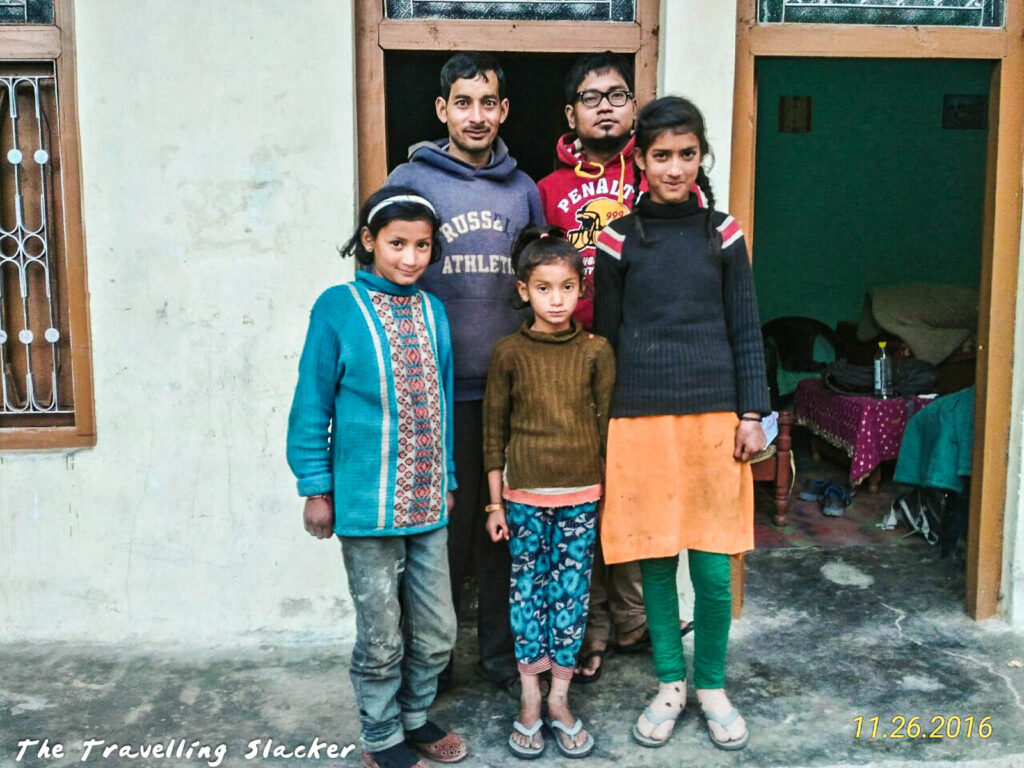
As promised, Bharatji gave us a room but also made it amply clear that there was no financial motive attached to his action and he was only fulfilling his “farz” (duty) as a local to help strangers.
Tapovan Springs: Smoking Hot… literally

We decided to visit the aforementioned hot water spring in the afternoon as it was not very far from there. We had to climb down from the village to the road through a different trail, reach the main road and then walk for a while to reach the spring which was mostly underwhelming. It is a small spot by the side of the road where sulphurous water can be seen boiling amidst the rocks. On the other side of the road a small facility has been built where locals mostly wash clothes. However, the mud of the spring is believed to be good for skin and we actually saw two men collecting the same in polythene bags. I took a short video, can you hear the boiling water?
A Quick Morning Ascent
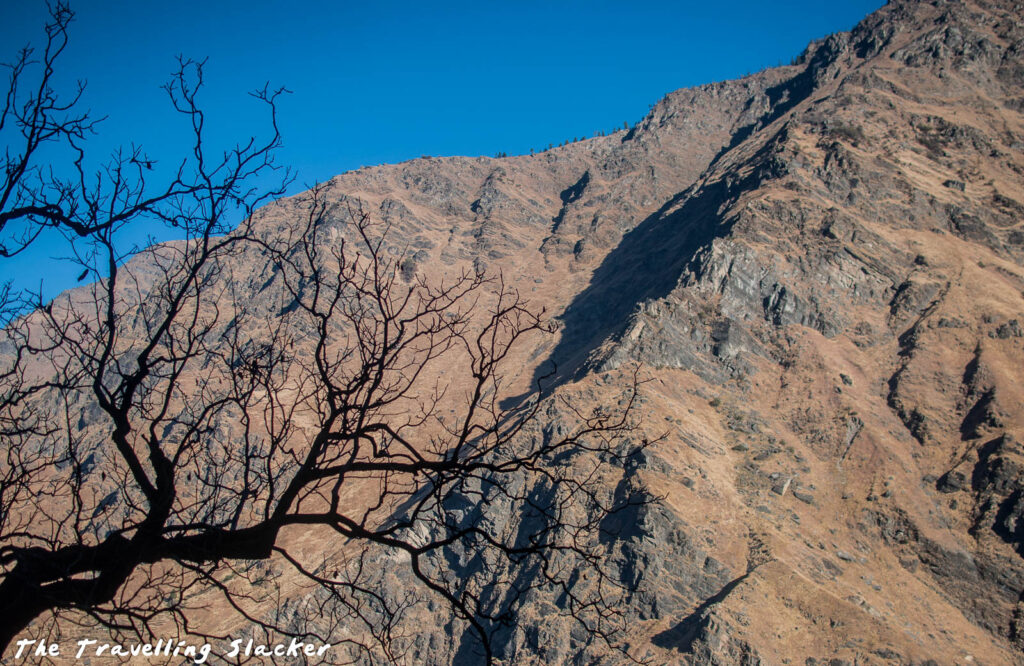
That night our hosts cooked rice, beans, and cabbages, all locally produced, as more fashionable people say, ethical and organic. The next morning we started early at around 7 am. The eldest daughter of Bharatji also joined us. Although she is a local, even she had not seen the temple. We could see the morning light illuminating the Nanda Devi however the shadow of the mountains kept casting shadow on most of the trail. Earlier this month, I’d planned to travel to the hills to capture autumn colours but those plans did not materialize. However, I was glad to see that the harsh winter was yet to set in and the orange and yellow hues of autumn was still visible in many of the trees while the pines were still green although the ripened cones were beginning to fall from the trees.

With our slow speed it took a couple of hours to reach Subhain village, the last village before the shrine. It looked even more precariously set than Ringi, just on the edge of the cliff. However, it was surprisingly greener for reasons beyond my comprehension. There is a smaller shrine for the deity here and these villagers generally look after the man shrine too. We took a short break here while local kids demanded to be photographed.


Beyond Subhain, even more coniferous jungles were waiting for us and it took one more hour to finally reach a shrine that we thought to be our destination, but it wasn’t! It was a comparatively newer shrine of an ascetic of great yogic achievements. He is believed to be still alive and living in one of the higher mountains but this shrine is a mark of respect. We were still clueless about the main shrine but that’s when Tyagiji appeared.
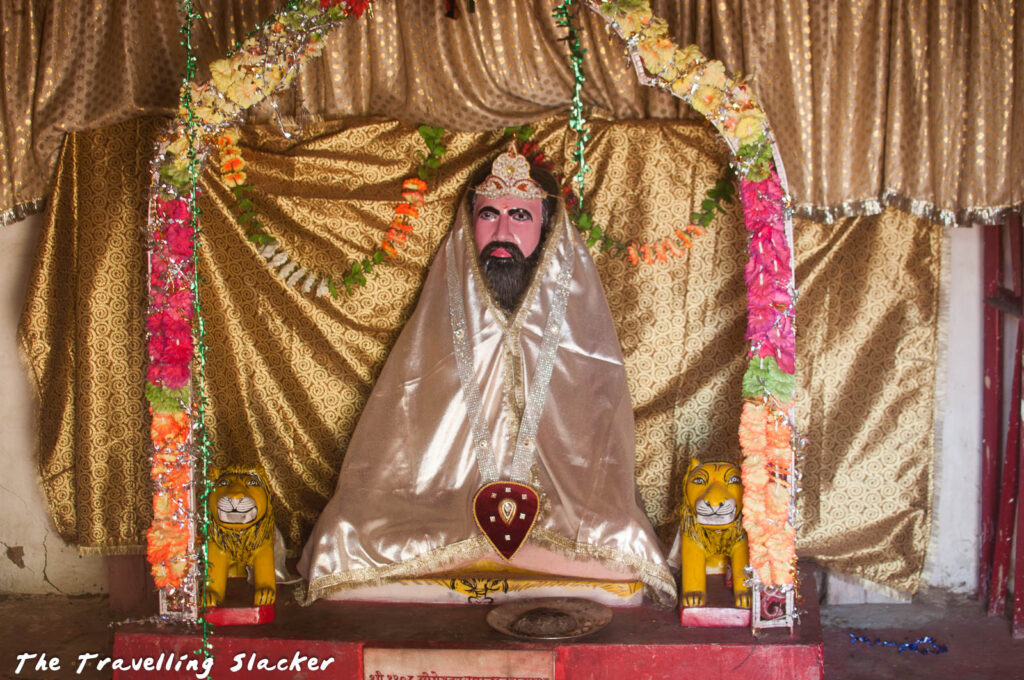
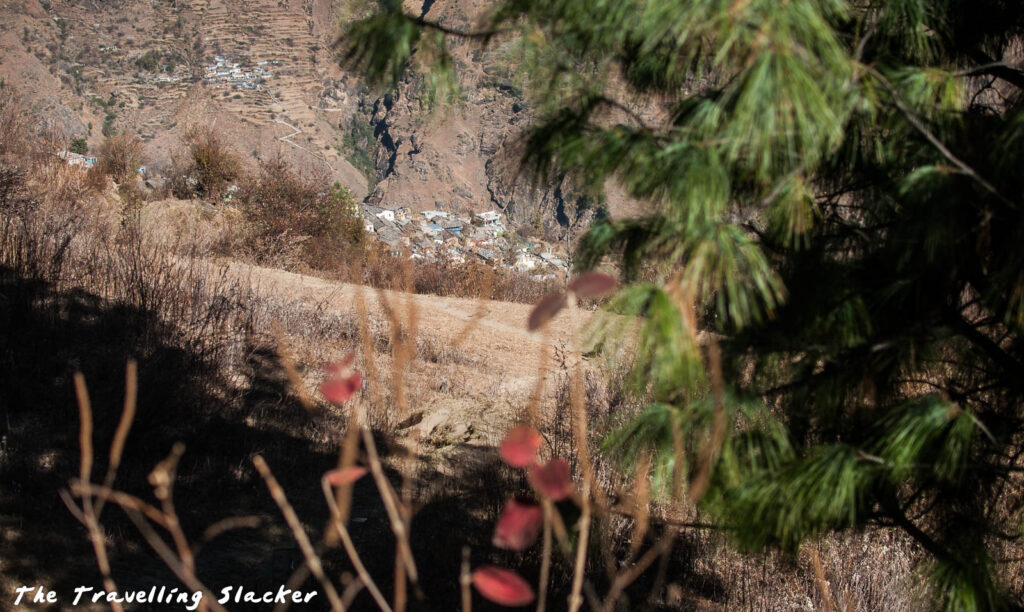
Tyagiji
Tyagi Maharaj lives in the small house behind the aforementioned shrine. He has been here for 18 years, and remains even during the peak of winter when his house gets buried in snow. He invited us for tea inside and we started talking. It was a long chat and all of it cannot be reproduced but basically what we learnt is that we had arrived there at the right moment because within a few days he was going to start is yearly “maun vrat” (vow of silence). He does not talk between December and February, goes into a shell and mediates. Yoga keeps him alive with very little consumption while the rest of the valley freezes in such zero temperature. However, we caught him at the right moment when he was in a talkative and jovial mood. He even offered hair care tips to Bharatjis daughter (his own hair is as long as he himself).



Finally, he took us to see the main Bhavishya Badri shrine which was a few steps above that point. The main shrine was actually somewhat underwhelming. The relic inside may be ancient but a new concrete building has been made around it without any aesthetic consideration. Nevertheless, he told us that the statue inside is slowly gaining shape. It was just a piece of stone earlier but it is now becoming more and more prominent. This surely goes well with the earlier story of the Narsingh which is shrinking. So, the calamity is not that far away!
The Bugyal of Eden
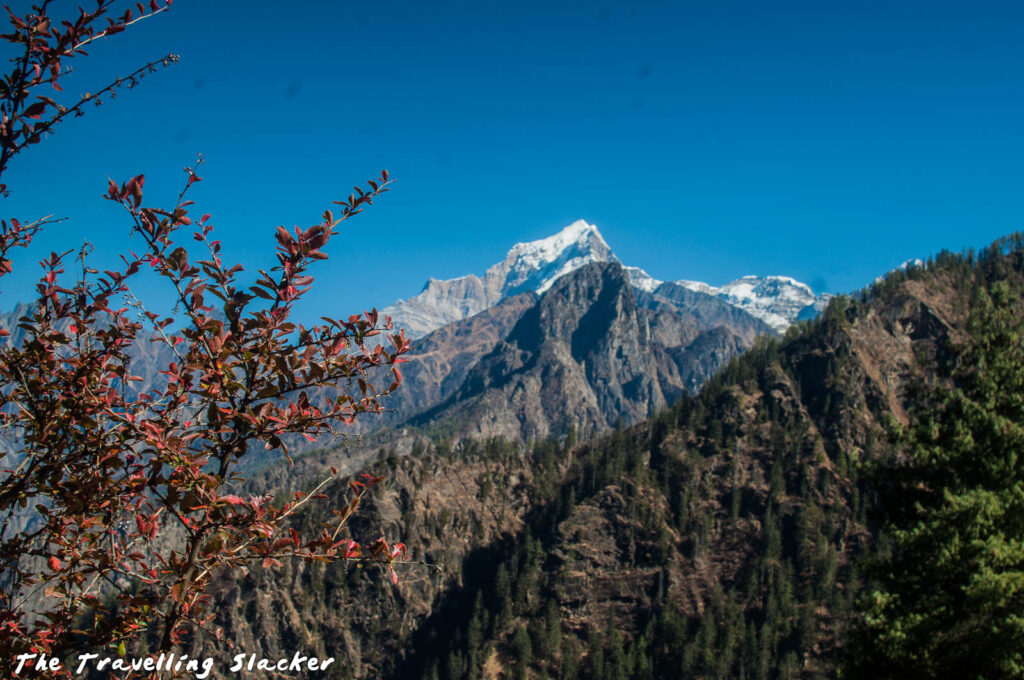

After spending some time at the temple, Tyagiji suggested that we should climb up a bit more to the small bugyal for better views and we soon realized that he was absolutely right. It was great location for 360 degree view of the entire Nit Valley. Nanda Devi, Dunagiri, as well as Nilkanth, were visible on various angles. I could only imagine how it would look during the summer when the flowers are in full bloom. We sat there soaking in the winter sun. The rest started meditating as I took photographs and listened to the flow of Rishi Ganga, a small stream that eventually meets the Dhauli Ganga.

We returned to Tyagiji’s hut where he served us lunch. He seemed to have all the provisions despite living in apparent isolation. In other news, he also owns a mobile phone but he told that he switches it off for those three silent months.
The Return
After lunch we again went up to the Bugyal and spent some more time before coming back while vowing to return again in the spring. We took a steeper and shorter path while return and it got dark soon. Due to fading light, most of my afternoon photos were not satisfactory but I did get one interesting view, that of a small stretch of Dhauli Ganga at a distance and at a much higher altitude.


We had to spend that night too at Bharatji’s household and came down quickly the next morning. The trip showed all signs of failure at the start however eventually it turned out to be one of the better trips in general and probably the most successful in terms of the interaction with local people. Besides, I am now more or less sure that much more needs to be explored in this Nanda Devi and Nit Valley region beyond the known shrines.
Bhavishya Badri Travel Guide
What exactly is Bhavishya Badri?
Bhavishya Badri is the last of the “Sapta Badris”. It is believed that when the mountains will collapse around the present-day temple of Badrinath, the new shrine will come up here. As of now, there is a small, temple is here and the main attraction is the natural beauty of the region.
How to Reach Bhavishya Badri?
You first need to reach Joshimath town, which is a 8-10 hour bus ride from Rishikesh. From there, find local transports. We actually reached Tapovan and then trekked till we got lost and rescued by locals. The two major villages en-route are Subhain and Ringi.
However, I have now learned that a motorable road has come up which goes very near to the temple. It actually made me sad because trek and the absence of autombiles were the ultimate joy of this trip.
Where to stay near Bhavishya Badri?
The nearest major place with hotels is Joshimath. There is one hotel in Tapovan, while we actually got sheltered by a family in a village as mentioned before. However, it was just a coincidence and I don’t recommend everyone to rush to the village hoping to get a stay.








Whenever your new posts come, first thing i do to go through all photos.
Very serene so beautiful 🙂 just love them
The 360 degree view from the top looks so amazing. It is always better to listen to the locals and go with what they say…after all, they want us to go back with happy memories!
Sorry about your recent illness! Your photos are stunning! Glad that it ended up being a good trip out even though the beginning wasn’t so smooth.
wonderful pictures..even the first one is so beautiful..i can’t believe you snapped it from a moving bus
What beautiful photographs and how elaborately, yet precisely you have explained everything. Reads like a story unfolding before my eyes!
Great story. So many things fell into place on this hike for you. That’s wonderful.
I love your pictures – the nature, the people and the general atmosphere. Tapovan looks amazing and I did not know it had a hote water spring there. Now I am itching to find out more – going to google it all. Thanks for sharing this 🙂
Stunning pictures like always and every your post, in this case landscape and lovely local people! It’s also possible to hear the sounds of the water while boiling, wow!! Thanks for sharing it 😀
Your Pictures says it all.It made me Travel along. Had fun reading . Thanks for the share.
That’s quite a memorable experience hanging out with Tyagi Maharaj. It’s impressive he’s able to live up there even when it gets cold. Sometimes I think 3 months silence and no phone would be good for myself as well but it’d be pretty difficult.
I wanna go there! Thank you so much for being such an inspiration to me. Nanda Devi stole my heart. Stunning pictures like always 🙂
I have only heard of mauni babas till today seeing one in pics for the first time here. I hope to meet too some day.
Hats off to your trekking spirits.
All the photos are stunning and perfectly describes the beauty of this place. Especially the first picture , eye catching.
The colour of the water looks absolutely amazing! So blue! And the hot springs are super interesting. The people seem lovely and friendly and welcoming too
It’s such a shame that the shrine will not be accessible anymore soon due to the mountain collapsing. Your journey up to see it was very beautiful and you have experienced some genuine hospitality from the locals. You were so lucky to catch Tyagi outside his silent months and that he was so kind to take you to the real shrine.
India is abode to so many beautiful pristine places and your posts unfurling those hidden gems always come as surprise to me. Your captures are stunning and am sure visiting them in person must be an incredible experience.
Oh men!! This post is one of those that make me want to leave everything and buy flight tickets to this destination!! This Bhavishya Badri Trek looks incredible and those pictures are stunning!! <3 <3 This region of north India is now in my bucketlist! thanks for sharing all this information!! Enjoy and travel!! E.
Always such wonderful photos! Looks like a beautiful area to wander around in. SO sad to hear about the shrine… but Mother Nature has a way of taking back what’s her’s,doesn’t she?
Your pictures are so captivating and can bound anyone to plan their next trip as Bhavishya Badri trek. Specially the one having snow capped mountain peeping through mountain range. If you remember those hair care tips, would you like to share with me?? 🙂
I love how you’re always unto exploring newer places! Your pictures are enough to make these places an addition on the bucket list 🙂
Parampara-Parichay
http://awaradiaries.com
India
I admire your freestyle travel. It is so liberating. Bharat ji’s story is touching. I have myself experienced such kindness during my travels in the remote corners of India.
Pingback: Gagron: Fortress on the Black Indus | The Travelling Slacker
Could you please tell me the distance between Subhain and Bhavishya Badri? How steep is the climb?How much time required?
Hi, it is around 3-4 KMs and should not take more than two hours from that point
The landscape looks so captivating and stark with those amazing mountains in the background, but the rural villages bringing you right up to present time and place – gorgeous vistas
I love your writing, especially your perspective and sense of place. I love it how you open with virus that are affecting your life and then hunting for things as trivial (from my American perspective) as an ATM without a line. Finally, you meet a real life holy man who takes significant vows of silence, but not this time of year and you get to just hang out and talk. That adventure is so completely foreign to me that I just love getting a slice of it in my life from your point of view.
All your photos are making me miss the Himalayas more than anything, now that am in the UK. You seem to have explored quite a bit by getting immersed into the local culture, and going off the book. Have been to chotpta and Joshimath before, but never really explored these small quaint havens.
Tyagi Maharaj sounds soooo interesting. I have never met anyone who has a vow of silence. I guess December to February is a good time; with winter, it’s easier to just stay indoors and not talk to anybody LOL This looks like a wonderful trek though. I’ve never been but it’s my cup of tea. Maybe someday.
Glad you were able to get another adventure in before winter truly set in! Your pictures look incredible! For the hot springs, did people actually swim in them? Or did they just use the water to do laundry and collect the mud?
What a gorgeous setting! Those mountains are stunning and it’s incredible people live in such isolated parts of the world.
We went to Badrinath Dham this April and there only we heard about the shrinking sculpture at Joshimath and shaping of future Badri Vishal temple but still missed visiting these shrines due to shortage of time. And now, after reading your post I know what else I have missed and need to explore here. Your pictures are beautiful as always. Loved your post.
Great writing but all I see pic is of Dronagiri aka Dunagiri like I saw from Taliban. But you keep on mentioning Nanda Devi.
Tapovan ? not Taliban I
Thanks for dropping by Sir…
Yes that might be that… I was never very good with peaks. I use Nanda Devi as a generic term in this region…
Thank you for your valuable information. We are planning to trek vabishya badri at this October. please inform me what is is the time required to trek to the top from the start point of the trek. Please tell me from where the motorable road ends ? Is it at Saldhar ? How far is it from Joshimath ?
Before Tyagiji, certain Lal Maharaj used to live near this shrine. I spent a day with him in 2005. He passed away, after one of his chela’s slipped his leg, fell into a ravine & died. Lal Maharaj didn’t live for more than a few months after that. Path from subhai gaon to Bhavish badri was covered with snow (I visited the place in November). The views of Nanda Devi from this shrine are spectacular. And the pines in the hill across are golden green maze. We kind of lost our way in return & walked almost 30 km to reach L&T construction site at Tapovan. Kind folk offered us hot tea at 11 pm (by the time we reached) & gave us a lift in one of their buses upto Joshimath, where we were put up. I took my nephew Ramanuja in that Trek.
Thanks for sharing this awesome story! Tyagiji mentioned of another one living in that area but we never met him.